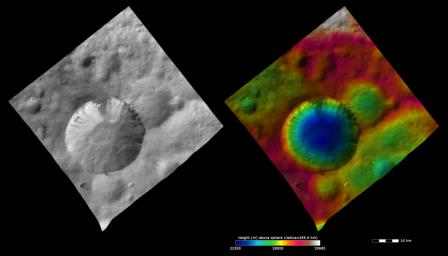
|
Topography and Albedo Image of Numisia Crater
- Click the image above for a larger view
- Full-Res JPEG (2450 x 1400) (212.4 kB)
- Full-Res TIFF (2450 x 1400) (10.3 MB)
Caption:
These Dawn FC (framing camera) images show the ~20km diameter Numisia crater, after which Numisia quadrangle is named. The left image is an albedo image, which is taken directly through the clear filter of the FC. Such an image shows the albedo (e.g. brightness/darkness) of the surface. The right image uses the same albedo image as its base but then a color-coded height representation of the topography is overlain onto it. The topography is calculated from a set of images that were observed from different viewing directions, allowing stereo reconstruction. The various colors correspond to the height of the area. The white area at the top of the image is the highest area and the blue area in the center of Numisia crater is the lowest area. The color-coded height image shows that Numisia crater impacted a relatively high (colored red) area and that Numisia crater is reasonably deep with steep sides. A smaller, more degraded impact crater, underneath Numisia crater to the right, is more clearly visible in the color-coded height image than in the albedo image. In the albedo image both dark and bright material is seen cropping out of and slumping down into Numisia crater.
These images are located in Vesta's Numisia quadrangle and the center latitude and longitude of the image is 5.9°S, 248.2°E. NASA's Dawn spacecraft obtained this image with its framing camera on October 21st 2011. This image was taken through the camera's clear filter. The distance to the surface of Vesta is 700 km and the image has a resolution of about 70 meters per pixel. This image was acquired during the HAMO (High Altitude Mapping Orbit) phase of the mission. The images are lambert-azimuthal map projected.
Background Info:
The Dawn mission to Vesta and Ceres is managed by NASA's Jet Propulsion Laboratory, a division of the California Institute of Technology in Pasadena, for NASA's Science Mission Directorate, Washington D.C. UCLA is responsible for overall Dawn mission science. The Dawn framing cameras have been developed and built under the leadership of the Max Planck Institute for Solar System Research, Katlenburg-Lindau, Germany, with significant contributions by DLR German Aerospace Center, Institute of Planetary Research, Berlin, and in coordination with the Institute of Computer and Communication Network Engineering, Braunschweig. The Framing Camera project is funded by the Max Planck Society, DLR, and NASA/JPL.
More information about Dawn is online at http://dawn.jpl.nasa.gov .
Cataloging Keywords:
| Name | Value | Additional Values |
|---|---|---|
| Target | 4 Vesta | |
| System | Main Belt | |
| Target Type | Asteroid | |
| Mission | Dawn | |
| Instrument Host | Dawn | |
| Host Type | Orbiter | |
| Instrument | Framing Camera (FC) | |
| Detector | ||
| Extra Keywords | Color, Crater, Impact, Map | |
| Acquisition Date | ||
| Release Date | 2011-12-12 | |
| Date in Caption | ||
| Image Credit | NASA/JPL-Caltech/UCLA/MPS/DLR/IDA | |
| Source | photojournal.jpl.nasa.gov/catalog/PIA15194 | |
| Identifier | PIA15194 | |
